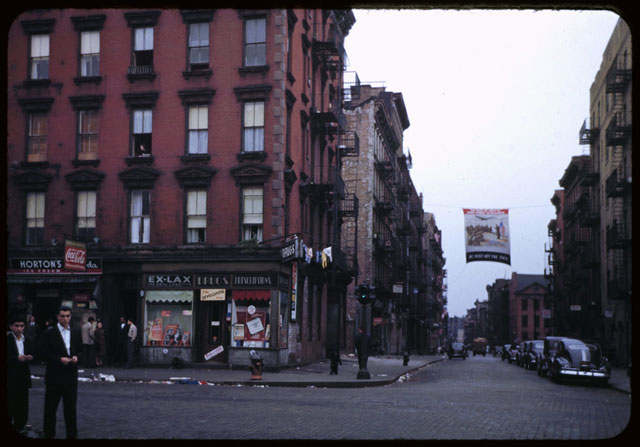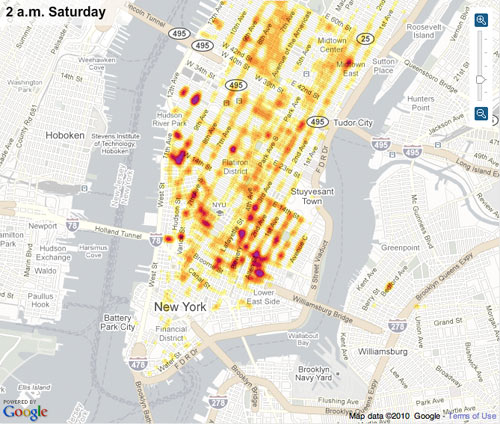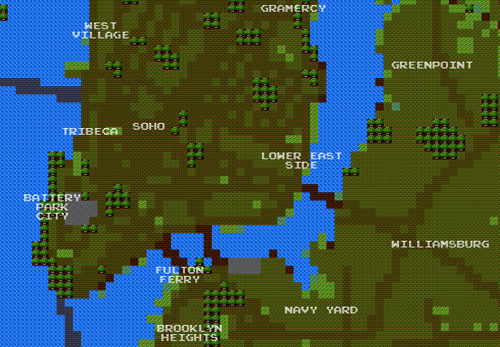New section of the High Line
Fast Company has a sneak preview of what the new section of the High Line park will look like. (thx, damien)



This site is made possible by member support. 💞
Big thanks to Arcustech for hosting the site and offering amazing tech support.
When you buy through links on kottke.org, I may earn an affiliate commission. Thanks for supporting the site!
kottke.org. home of fine hypertext products since 1998.
Fast Company has a sneak preview of what the new section of the High Line park will look like. (thx, damien)
A new Subway has recently opened in Manhattan…hanging on the outside of the 27th floor of the skeleton of 1 World Trade Center. The Subway will move upwards as the building is constructed and it is hoped that construction workers will dine there instead of heading off-site for long lunches via a slow hoist.
“I don’t think the veggies will be a big seller,” said Mr. Schragger, who owns four other Subways in Manhattan. “I imagine most of the guys will want protein. Philly Cheesesteaks and the Feast.”
Philly Cheesesteaks and the Feast would be a great name for a band.
I’ve only had a few of these…I am clearly not exercising my sandwich muscles enough these days. (Although the Brazilian sandwich at Project Sandwich has been treating me well lately.)
Pictory has a slideshow up of New York City photos. Design by Nicholas Felton, photos curated by Josh Haner of the New York Times Lens blog.
In an attempt to eliminate Manhattan’s travel inefficiencies and encourage more use of public transportation, Charles Komanoff spent three years creating an Excel spreadsheet (you can download it here) that details “the economic and environmental impact of every single car, bus, truck, taxi, train, subway, bicycle, and pedestrian moving around New York City”. Based on that research, he’s come up with a plan for changing how transportation is paid for in Manhattan below 60th St. (the CBD or central business district).
It would charge $3 to cars entering the CBD on weekday nights, $6 for most of the day, and $9 during rush hour. The subway fare also varies, but is always less than the $2.25 it is today: $1 at night, rising to $1.50 as day breaks, and peaking at $2 during weekday rush hours. Buses are always free, because the time saved when passengers aren’t fumbling for change more than makes up for the lost fare revenue. Komanoff’s plan also imposes a 33 percent surcharge on every taxi ride, 10 percent of which would go to the cab driver and the rest to the city.
Komanoff’s plan is vastly more sophisticated than a simple bridge toll. Instead of merely punishing drivers, he has built a delicate system of incentives and revenue streams. Just as a musical fugue weaves several melodic lines into a complex yet harmonious whole, Komanoff’s policy assembles all the various modes of transportation into a coherent, integrated traffic system.
Next month, the MTA will release a new subway map. The NY Times has a look at the new map.
The new subway map makes Manhattan even bigger, reduces Staten Island and continues to buck the trend of the angular maps once used here and still preferred in many other major cities. Detailed information on bus connections that was added in 1998 has been considerably shortened.
Manhattan will be shown on the map as nearly twice as wide as in real life. Cut back on the chili-cheese fries, my friend!
A Times Square tshirt vendor alerted police to an oddly parked truck near his stand. A bomb squad found a crudely built bomb inside the truck.
When asked if he was proud of his actions, he said: “Of course, man. I’m a veteran. What do you think?” The vendor said that he had served during the Vietnam War and had been selling wares on the street for about 20 years. “I don’t have too much of a choice, nobody’s giving me a job,” he said.
The Bloomberg administration is considering splitting 34th Street into three parts: an westbound-only section from the Hudson to 6th Ave, an eastbound-only section from 5th Ave to the East River, and a pedestrian-only section from 5th to 6th Aves.
Buses would still operate in both directions, and through the pedestrian plaza as well, but in dedicated lanes separated from passenger cars by a concrete barrier. […] A city study showed that only one in 10 people travel along 34th Street by car, including taxis; the rest walk or use mass transit. Faster buses would benefit “the majority of the people who are actually using the street”.
Wow!
Eddie Feibusch opened his Manhattan zipper store on December 7, 1941 and is still plying his trade there, even after most of his competition has decamped for cheaper overseas locations.
How great are zippers? Don’t even get Mr. Feibusch started. They are watertight for deep-sea divers, airtight for NASA. “Nothing replaces a zipper,” he said. Buttons? He made a face. “A button is unpleasant,” he said.
Feibusch will even sell you a 30-foot-long zipper for $100…to wrap your hot-air balloon up. (via girlhacker)
Doree Shafrir wrote this week’s New York magazine cover story on the NYC tech/media start-up scene. It’s the first one I’ve read in awhile in which Tumblr’s not the centerfold. Foursquare is the new hotness I guess.
Culled primarily from the Charles W. Cushman collection, a selection of color photographs of NYC taken in the 40s, 50s, and 60s: Downtown 1941, Downtown 1960, Lower East Side, and Miscellaneous. Here’s a shot of Canal St in 1942 (with cobblestones!):

Does anyone know which corner this is? (Here’s another view.) I poked around on Google Maps for a bit trying to find it, but I fear that building is long gone…Canal St, particularly the western part, is much changed since the 1940s.
Everett Fahy, the former head of the European painting department at the Met, believes that one of the museum’s paintings by Francesco Granacci is actually by Michelangelo.
I believe Michelangelo painted it in 1506, two years before he started on the Sistine ceiling. It was already in my brain in 1971, the year after it was bought. When the Metropolitan showed it in 1971, I wrote for an exhibition called ‘Masterpieces of Fifty Centuries’ that the second panel recalled the figures in the Sistine Chapel. As years went by, it firmed up. I had long believed it to be by Michelangelo, but exactly when I don’t know. There wasn’t a moment when I suddenly said, ‘This is absolutely by Michelangelo.’ It was a gradual recognition.
One the clues Fahy used to make his determination involves the rocks in the painting; they resemble the quarry at which Michelangelo spent several months in 1497. The painting can be viewed larger on the Met’s website.
Accompanied by a New Yorker writer, Christopher Walken visits Astoria, Queens, the neighborhood he grew up in.
“Hello, my name is Chris Walken,” he said. “This is very nice of you. When I was little, I used to have my diaper changed on the kitchen table here.” He stayed in the kitchen, a polite house guest. After a minute, he said, “Well, this was very interesting. God bless and good luck!” (“This sounds silly,” he said later, “but the first thing that I can remember I was on my back, on that kitchen table, and the window facing the street was open. I remember this marvellous warm breeze coming in, so it was around June, and I was a couple of months old. And I turned my head and right next to me was a white plate with scrambled eggs on it. I can still see it.”)
(via clusterflock)
Pixelized video game characters lay waste to NYC.
Give it a few seconds to get going…things get good right around Tetris time.
Nice timelapse map view of taxi traffic across Manhattan.

I’ve often wondered what an NYC version of Stamen’s Cabspotting project would look like.
If the population density of the United States was equal to that of Brooklyn, the entire US population would fit into New Hampshire.
The state would be ruined, though (imagine a Brooklyn-like sprawl of that size), but the rest of the country would be green and pleasantly devoid of people!
If you used Manhattan’s population density, Dense US would shrink to more than half that size, roughly the area of Teton County in Wyoming. Manila, the capital of the Philippines, has the highest population density of any city in the world (111,000 people per square mile)…if the US was that dense, the population would fit into any number of tiny Alaskan islands you’ve never heard of or a square 52 miles on a side.
NYC’s Board of Health has lifted the ban on keeping bees in the city.
The unanimous vote amends the health code to allow residents to keep hives of Apis mellifera, the common, nonaggressive honeybee. Beekeepers will be required to register with the Department of Health and Mental Hygiene and to adhere to appropriate practices. That means they must be able to control bee swarms and ensure that the hives do not interfere with pedestrians or neighbors.
Ten dollars says my wife utters the following words to me tonight: “we should raise some bees on the roof!”
Do yourself a favor: take the next five minutes and watch this tilt-shift video of NYC in fullscreen HD. The construction stuff that starts about a minute in is just great.
Whereas Koyaanisqatsi made NYC look big and busy, The Sandpit turns the city into something you can hold in your hands or put in your pocket. The making of is worth a read…all the tilt-shift effects were done in post. (via quips)

Fully draggable, zoomable, Zelda-like map of NYC…this is awesome. But where are the Octoroks? (via waxy)
Showing at MoMA next month, a documentary based on the NY Times’ relentless and intrepid street photographer Bill Cunningham. From the press release:
The opening night feature of this year’s New Directors/New Films is the world premiere of Bill Cunningham New York (USA, 2010) on Wednesday, March 24, at 7:00 p.m. at MoMA. Director Richard Press’ documentary is a heartfelt and honest film about the inimitable New York Times photographer, who has for decades lovingly captured the unexpected trends, events, and people of Manhattan for the Styles section of the newspaper. The film shows Cunningham, an octogenarian, riding his Schwinn bicycle to cover benefits, galas, and fashion shows around Manhattan, and illustrates how his camera has captured the looks that have defined generations.
I couldn’t really find any other information online about this film. They should at least get a trailer up on YouTube or something.
Update: No trailer yet, but there’s a web site for the film with screening info, etc.
Greg Sloane, who calls the streets of New York home, thinks that Avatar should win best picture at the Oscars.
“I hope ‘Avatar’ wins so they keep it in theaters longer,” he said. “It’s three hours long, so you get more time to sleep.”
The lineup for the 2010 Gel conference in NYC is shaping up nicely. Regular kottke.org readers will likely be interested in hearing Will Shortz (NY Times crossword puzzle dude), the Gregory brothers (Auto-Tune the News), Randy Garutti (COO of Shake Shack), Rachel Sussman (photographer of the world’s oldest living things), and Matt Freakin’ Haughey.
Shaquille O’Neal curated an art exhibition that opened this weekend at Flag Art Foundation in Chelsea.
Do you ever get time to visit museums?
I used to go a lot with my kids. Donald Trump is a great friend, and he has four or five Picassos on his plane. And that’s where I would look at them. One time, I was at a museum and tried touching a Picasso. You break it, you buy it, they said. I was told it would cost $2 million.
The true New Yorker secretly believes that people living anywhere else have to be, in some sense, kidding.
That’s John Updike. (via swissmiss)
Comedian Mark Malkoff set out to disprove that New Yorkers are unfriendly and unhelpful by cajoling people into carrying him the length of Manhattan.
Hilarious. He made it all the way up to 141st St & Broadway! (thx, micah)
Foodprint is not your typical NYC food gathering. From Edible Geography:
The free afternoon program will consist of four panel discussions: “Zoning Diet,” about the hidden corsetry of policy, access, and economics that gives shape to urban food distribution; “Culinary Cartography,” a look at the kinds of things we can learn about New York City when we map its food types and behaviours; “Edible Archaeology,” about the socio-economic forces, technical innovations, and events that have shaped New York food history, in the context of the present; and “Feast, Famine, and Other Scenarios,” an opportunity to collaboratively speculate on changes to the edible landscape of New York in both the near and distant future.
The event takes place in NYC on Feb 27th; it’s free and the entire thing will be available online as well.
The interactive map on the NYC govt site has hi-resolution aerial photos from 1924 (click the camera and move the slider to 1924). Check out all the piers, the Brooklyn Navy Yard, the old baseball stadiums, the LES (and everywhere else they built housing projects), Penn Station, and the skyscraperless Midtown. This is hours of fun.
Update: The NYC Oasis map features a satellite view from 1996 and an imagined sat view from 1609. (thx, steve)
Someone sent this to me ages ago and I forgot to post it but luckily I ran across it again this morning: A Failed Entertainment is a show at The LeRoy Neiman Gallery featuring the films of James Incandenza…you know, the ones from the 8-page footnote in Infinite Jest.
Included as a footnote in Wallace’s novel is the Complete filmography of James O. Incandenza, a detailed list of over 70 industrial, documentary, conceptual, advertorial, technical, parodic, dramatic non-commercial, and non-dramatic commercial works. The LeRoy Neiman Gallery has commissioned artists and filmmakers to re-create seminal works from Incandenza’s filmography.
No word on whether any of the filmmakers made JOI’s Infinite Jest…I guess we’ll find out if anyone emerges from the opening reception tonight.
Stay Connected